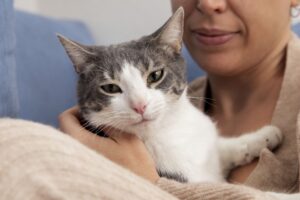Scratching. We love it and our pets love it when we get a satisfying scratch to relieve an itch.
The reason why scratching feels good is because it sends a low-level of pain signal to our brain which overrides the itch signal. This is also why pinching, slapping or drawing an “X” on the itchy spot works too.
However, animals would usually satiate the itch by scratching, licking or rubbing a particular spot. Hence if you’ve noticed them doing that more than normal, they might be having a skin condition.
Here are some of the most common symptoms of skin problems that should signal a trip to the vet:
- Excessive itching, scratching, rubbing or licking
- Hair loss
- Appearance of open sores, spots, pimples or patches that are red, flaky or scaly
- Appearance of scabs, crusts or thickened skin
- Bad skin odor
Causes And Types Of Skin Conditions
1. Parasites, Fleas and Mites
Sometimes these little buggers may latch onto your furkid after they’ve had a roll about outside or come in contact with other infested pets. Or it could be from a batch of old Kibble as it tends to become a breeding ground for bacteria, mites, and mycotoxins due to oxidation after 2 weeks.
Types of skin conditions:
- Fleas: Dogs and cats are sensitive to fleas and can develop allergies to the flea’s saliva transferred via its bites. Other than excessive scratching or licking, hot spots or scabs may start forming. In worst cases, severe flea infestations can cause blood loss, anemia and exposure to other parasites such as tapeworms. Should this occur, you should definitely disinfect your furniture, bedding and rugs too.
- Ear Mites: Drawn to the wax and oils inside an animal’s ear, they can cause a serious skin or ear infection. Typical signs would be excessive ear scratching, head shaking and a strong odor and dark discharge from the ears.
- Mange: Caused by mites, canine scabies spreads easily among dogs and is transferable to people. Symptoms are intense itching, red skin, sores and hair loss on a dogs ears, face and legs. However, demodectic mange is a non-contagious skin disorder that appears as bald spots, scabbing and sores.
- Lice: These light coloured critters are usually quite species-specific and hence cross infestation is highly unlikely. These parasites feed on dry skin and are commonly found on young, neglected pets. Large infestations can lead to scratching, restlessness, unusual coat appearance and hair loss.
- Ticks: They’re often big enough to spot with the naked eye and feel like lumps or bumps on your pets skin. They tend to attach themselves around the head, neck, ear and feet areas. To properly remove a tick, grasp it with tweezers close to the skin and gently pull straight out. Don’t twist or jerk the tick because this can cause the mouth-parts to break off and remain in the skin. If this happens, remove the mouth-parts with tweezers.
2. Infections
Bacterial and fungal infections can be caused by a number of reasons including allergies, open wounds or cuts.
Types of skin conditions:
- Impetigo: Typically develops as a result of another skin problem such as from acne. It causes pus-filled blisters that may break and crust over. These blisters usually develop on the hairless portion of the abdomen.
- Yeast Infections: Most commonly found in their ears and is caused by a fungus. Symptoms may include a black or yellow discharge, redness of the ear flap and persistent scratching of the ear. It could also happen on the paws as it’s a warm and snug environment for fungi to thrive.
- Ringworm: Inflamed, scaly patches and hair loss typically surround the circular lesions. Puppies and kittens less than a year old are the most susceptible to this particular virus. If not treated quickly, it can spread quickly to the other pets at home and humans.
3. Stress
Emotional and physical stress have been shown to exacerbate physical issues including hypothyroidism and skin allergies. Sometimes a pet’s maladaptation to a sudden environmental change or habit, such as not having a source of energy outlet, could cause them to be stressed out.
Types of skin conditions:
- Feline / Canine Acne: Typically appears as red bumps or pustules on and around a cat’s chin or lips and skin of a dogs muzzle. In severe cases, it can lead to generalised swelling, bleeding wounds or sores which are prone to bacterial infection if left untreated. These wounds would also lead to scabbing.
- Alopecia: Alopecia is the medical term for baldness. It can be a result of ringworm, mange, or other diseases. But it could also be caused by stress or poor nutrition, which makes your pet lose more hair than usual. It might appear as patches of missing fur and excessive shedding for more than a week.
- Acral Lick Granuloma: Cats groom themselves naturally. However, cats may groom compulsively or excessively in response to stress or a medical problem such as arthritis. The relentless licking of a single area due to pain and itching may lead to irritation, infection and thinning hair.
4. Allergies
Similar to us, our pets can have allergic reactions to various allergens found in pollen, insect bites, mold, food, close contact materials and even chemicals in shampoos or other products. While medications can help relieve and cure the itch, it’s best to completely remove the allegent from coming in contact with our furkids.
Types of skin conditions:
- Allergic Dermatitis: Appears as excessive scratching and hair loss or skin lesions anywhere on the body due to being allergic to products used, food consumed or environmental irritants.
- Dry, Flaky Skin: It’s a common symptom of allergies, mange and other skin diseases. But it’s usually not a serious issue. However, if it’s causing your pet discomfort, you should consult your veterinarian or nutritionist for a fatty acid supplement.
- Hot Spots: Also called acute moist dermatitis, they’re small areas that appear red, irritated and inflamed. If left untreated, it can quickly grow in size and the infected area will look wet and slightly yellow from pus. This condition can be a result from a wide range of conditions including infections, allergies, insect bites or excessive licking and chewing at a single spot. It wouldn’t be able to heal on its own, but it is easily treated with prescriptions from the vet.
Other Concerning Signs
- Color or Texture Changes: Changes in your pets’ skin color or coat texture can be a warning sign of several common metabolic or hormone problems. It could also be due to an infection or other skin disorders. Usually a simple blood test can identify the underlying cause.
- Skin Tumors: A lump in your pets skin is not necessarily cancer but should definitely be checked by a veterinarian.



















